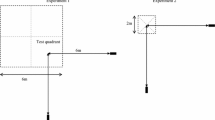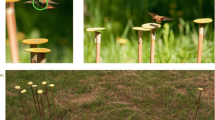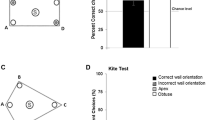Abstract
Rats, birds or fish trained to find a reward in one corner of a small enclosure tend to learn the location of the reward using both nearby visual features and the geometric relationships of corners and walls. Because these studies are conducted under laboratory and thereby unnatural conditions, we sought to determine whether wild, free-living rufous hummingbirds (Selasphorus rufus) learning a single reward location within a rectangular array of flowers would similarly employ both nearby visual landmarks and the geometric relationships of the array. Once subjects had learned the location of the reward, we used test probes in which one or two experimental landmarks were moved or removed in order to reveal how the birds remembered the reward location. The hummingbirds showed no evidence that they used the geometry of the rectangular array of flowers to remember the reward. Rather, they used our experimental landmarks, and possibly nearby, natural landmarks, to orient and navigate to the reward. We believe this to be the first test of the use of rectangular geometry by wild animals, and we recommend further studies be conducted in ecologically relevant conditions in order to help determine how and when animals form complex geometric representations of their local environments.



Similar content being viewed by others
References
Batty ER, Bloomfield LL, Spetch ML, Sturdy CB (2009) Comparing black-capped (Poecile atricapillus) and mountain chickadees (Poecile gambeli): use of geometric and featural information in a spatial orientation task. Anim Cognit 12:633–641
Brown AA, Spetch ML, Hurd PL (2007) Growing in circles: rearing environment alters spatial navigation in fish. Psychol Sci 18:569–573
Cheng K (1986) A purely geometric module in the rat’s spatial representation. Cognition 23:149–178
Cheng K, Sherry DF (1992) Landmark-based spatial memory in birds (Parus atricapillus and Columba liva): the use of edges and distances to represent spatial positions. J Comp Psychol 106:331–341
Cheng K, Huttenlocher J, Newcombe NS (2013) 25 years of research on the use of geometry in spatial reorientation: a current theoretical perspective. Psychon Bull Rev 20:1033–1054
Chiandetti C, Vallortigara G (2008) Is there an innate geometric module? Effects of experience with angular geometric cues on spatial re-orientation based on the shape of the environment. Anim Cognit 11:139–146
Collett M (2012) How navigational guidance systems are combined in a desert ant. Curr Biol 22:927–932
Flores-Abreau IN, Hurly TA, Healy SD (2012) One-trial spatial learning: wild hummingbirds relocate a rewarding location after a single visit. Anim Cognit 15:631–637
Freire R, Munro U, Rogers LJ, Wiltschko R, Wiltschko W (2005) Chickens orient using the magnetic compass. Curr Biol 15:R620–R621
Fuxjager MJ, Eastwood BS, Lohmann KJ (2011) Orientation of hatchling loggerhead sea turtles to regional magnetic fields along a transoceanic migratory pathway. J Exp Biol 214:2504–2508
Gibson BM, Wilks TJ, Kelly DM (2007) Rats (Rattus norvegicus) encode the shape of an array of discrete objects. J Comp Psychol 121:130–144
Gray ER, Spetch ML, Kelly DM, Nguyen A (2004) Searching in the center: pigeons (Columba livia) encode relative distance from walls of an enclosure. J Comp Psychol 118:113–117
Gray ER, Bloomfield LL, Ferrey A, Spetch ML, Sturdy CB (2005) Spatial encoding in mountain chickadees: features overshadow geometry. Biol Lett 1:314–317
Guilford T, Akesson S, Gagliardo A, Holland RA, Mouritsen H, Muheim R, Wiltschko R, Wiltschko W, Bingman VP (2011) Migratory navigation in birds: new opportunities in an era of fast-developing tracking technology. J Exp Biol 214:3705–3712
Healy SD, Hurly TA (1998) Rufous hummingbirds’ (Selasphorus rufus) memory for flowers: patterns or actual spatial locations? J Exp Psychol Anim Behav Process 24:396–404
Healy SD, Hurly TA (2013) What hummingbirds can tell us about cognition in the wild. Comp Cognit Behav Rev 8:13–28
Hurly TA, Healy SD (1996) Memory for flowers in rufous hummingbirds: location or local visual cues? Anim Behav 51:1149–1157
Hurly TA, Healy SD (2002) Cue use by rufous hummingbirds (Selasphorus rufus). J Exp Psychol Anim Behav Process 28:209–223
Hurly TA, Scott RD, Healy SD (2001) The function of displays of male rufous hummingbirds. Condor 103:647–651
Hurly TA, Franz S, Healy SD (2010) Do rufous hummingbirds (Selasphorus rufus) use visual beacons? Anim Cognit 13:377–383
Kamil AC, Balda RP, Good S (1999) Patterns of movement and orientation during caching and recovery by Clark’s nutcrackers, Nucrifraga columbiana. Anim Behav 57:1327–1335
Kelly DM (2010) Features enhance encoding of geometry. Anim Cognit 13:453–462
Kelly DM, Spetch ML (2001) Pigeons encode relative geometry. J Exp Psychol Anim Behav Process 27:417–422
Kelly DM, Spetch ML, Heth CD (1998) Pigeons’ encoding of geometric and featural properties of a spatial environment. J Comp Psychol 112:259–269
Krebs JR, Healy SD, Shettleworth SA (1990) Spatial memory of Paridae: comparison of a storing and a non-storing species, the coal tit, Parus ater, and the great tit, P major. Anim Behav 39:1127–1137
Lee SA, Spelke ES, Vallortigara G (2012a) Chicks, like children, spontaneously reorient by three-dimensional environmental geometry, not by image matching. Biol Lett 8:492–494
Lee SA, Vallortigara G, Ruga V, Sovrano VA (2012b) Independent effects of geometry and landmark in a spontaneous reorientation task: a study of two species of fish. Anim Cognit 15:861–870
Lee SA, Vallortigara G, Flore M, Spelke ES, Sovrano VA (2013) Navigation by environmental geometry: the use of zebrafish as a model. J Exp Biol 216:3693–3699
Margules G, Gallistel CR (1988) Heading in the rat: determination by environmental shape. Anim Learn Behav 16:404–410
Miller RS, Tamm S, Sutherland GD, Gass CL (1985) Cues for orientation in hummingbird foraging: color and position. Can J Zool 63:18–21
Nardi D, Nitsch KP, Bingman VP (2010) Slope-driven goal location behavior in pigeons. J Exp Psychol Anim Behav Process 36:430–442
Ohashi K, Thomson JD, D’Souza D (2007) Trapline foraging by bumble bees: IV. Optimization of route geometry in the absence of competition. Behav Ecol 18:1–11
Pecchia T, Vallortigara G (2010) Reorienting strategies in a rectangular array of landmarks by domestic chicks (Gallus gallus). J Comp Psychol 124:147–158
Pecchia T, Vallortigara G (2012) Spatial reorientation by geometry with freestanding objects and extended surfaces: a unifying view. Proc R Soc B 279:2228–2236
Sokal RR, Rohlf FJ (1995) Biometry, 3rd edn. WH Freedman, New York
Sovrano VA, Bisazza A, Vallortigara G (2005) Animals’ use of landmarks and metric information to reorient: effects of the size of the experimental space. Cognition 97:121–133
Sutton JE (2009) What is geometric information and how do animals use it? Behav Proc 80:339–343
Tommasi L, Chiandetti C, Pecchia T, Sovrano VA, Vallortigara G (2012) From Natural geometry to spatial cognition. Neurosci Biobehav Rev 36:799–824
Vargas JP, Quintero E, López JC (2011) Influence of distal and proximal cues in encoding geometric information. Anim Cognit 14:351–358
Vlasak A (2006) Global and local spatial landmarks: their role during foraging by Columbian ground squirrels (Spermophilus columbianus). Anim Cognit 9:71–80
Waser NM, McRobert JA (1998) Hummingbird foraging at experimental patches of flowers: evidence for weak risk-aversion. J Avian Biol 29:305–313
Wiltschko W, Balda RP, Jahnel M, Wiltschko R (1999) Sun compass orientation in seed-caching corvids: its role in spatial memory. Anim Cogn 2:215–221
Wystrach A, Beugnon G, Cheng K (2011) Landmarks or panoramas: what do navigating ants attend to for navigation? Front Zool 8:21
Acknowledgments
We thank Mark Hornsby, Ken Cheng and two anonymous reviewers for valuable discussion or helpful comments on the manuscript. Logistical support was provided by the University of Lethbridge and financial support by the Natural Sciences and Engineering Research Council of Canada (TAH, TAOF, DMZ) and the Association for the Study of Animal Behaviour (SDH).
Conflict of interest
None of the authors have conflicting financial relationships with any of the funding or approval agencies associated with the research reported here.
Ethical standard
This research was conducted with the approval of the University of Lethbridge Animal Welfare Committee, meeting the standards of the Canadian Council on Animal Care, and under permits from the Canadian Wildlife Service and Alberta Sustainable Resource Development.
Author information
Authors and Affiliations
Corresponding author
Rights and permissions
About this article
Cite this article
Hurly, T.A., Fox, T.A.O., Zwueste, D.M. et al. Wild hummingbirds rely on landmarks not geometry when learning an array of flowers. Anim Cogn 17, 1157–1165 (2014). https://doi.org/10.1007/s10071-014-0748-x
Received:
Revised:
Accepted:
Published:
Issue Date:
DOI: https://doi.org/10.1007/s10071-014-0748-x




